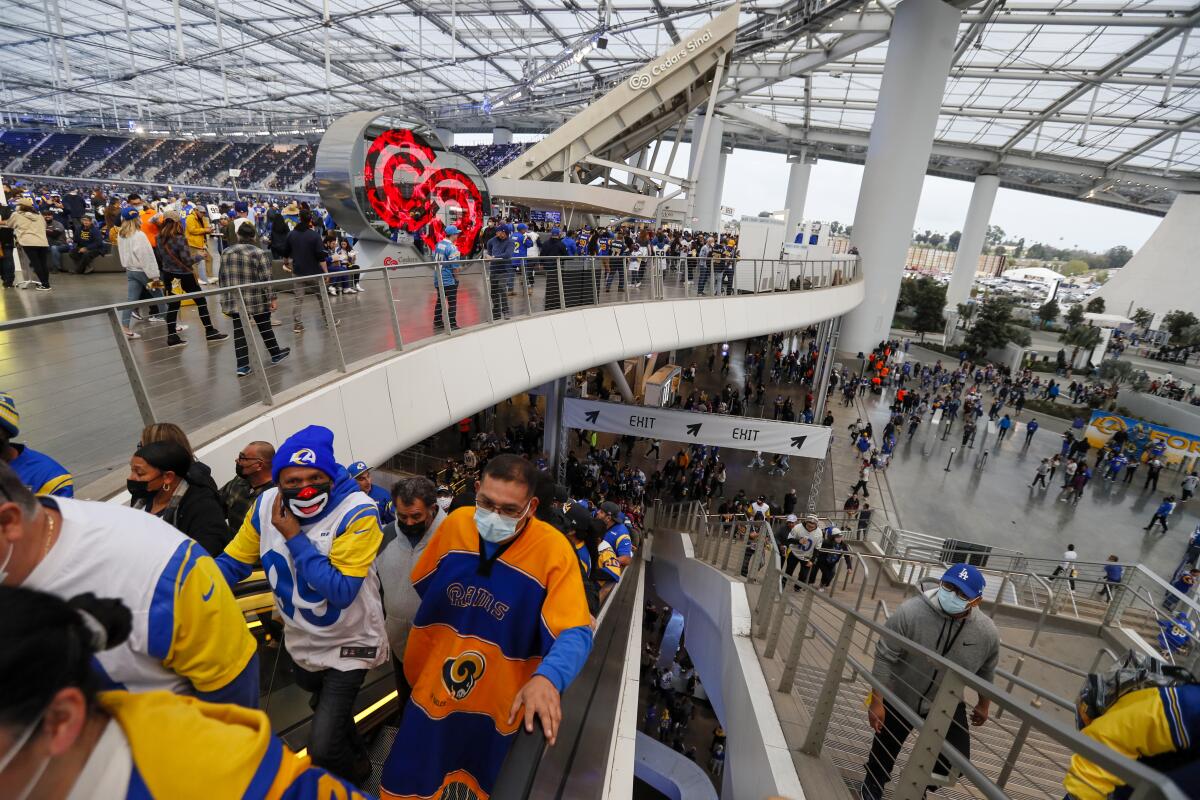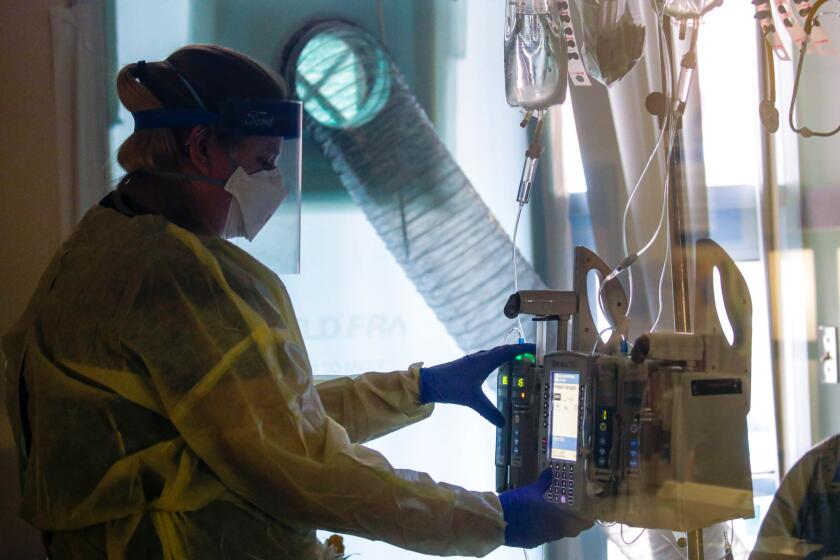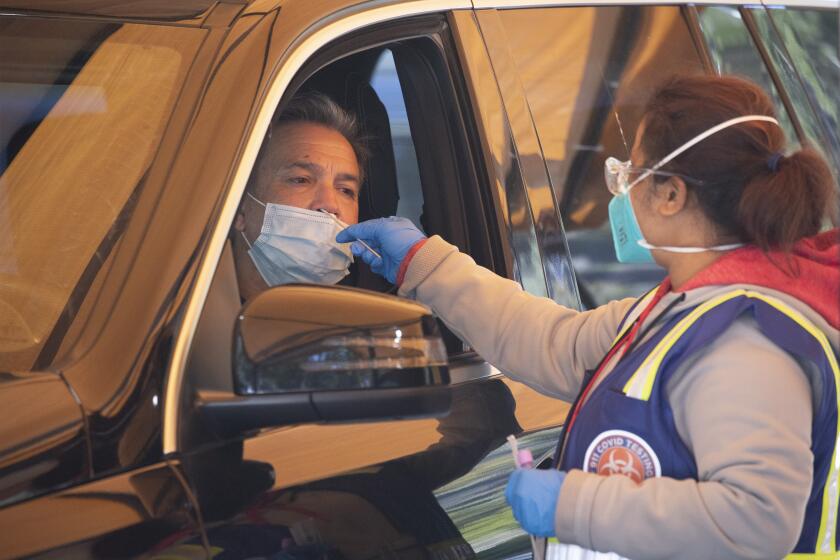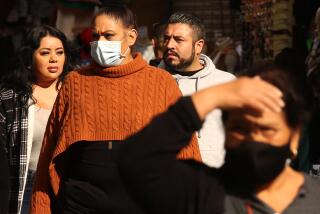Super Bowl guests to get KN95 masks at SoFi Stadium

Face masks will be given to spectators watching the Super Bowl at SoFi Stadium in Inglewood, officials announced Tuesday, to ensure COVID-19 protocols are met at the event, which is a little more than two weeks away.
The masks — KN95 varieties — will be handed out as part of health and safety plans ahead of the Feb. 13 game.
L.A. County’s health officer order requires that patrons, customers and guests wear masks at “outdoor mega events,” now defined as those hosting 5,000 or more people, regardless of whether they’ve been vaccinated against COVID-19.
Los Angeles County has long-standing rules — issued in August — requiring masks to be worn at large outdoor events such as games and concerts at SoFi and Dodger stadiums, the Los Angeles Memorial Coliseum and the Hollywood Bowl.
“Masks are required at all times to enter all of the events, to be in common areas, to purchase at concession stands and at indoor shops,” Los Angeles County Public Health Director Barbara Ferrer said.
The county’s health order does not dictate the type of masks that spectators are required to wear and does not instruct fans to use the masks that will be provided. But California health officials have been increasingly urging residents and workers to use higher-quality face masks to give themselves an extra layer of protection.
There remains considerable debate about the pandemic’s trajectory, but scientists generally say it’s too early to declare an ‘endgame’ for COVID-19.
While health officials and experts have said that the best masks are N95, KN95 and KF94 masks and that better masks involve placing a cloth mask over a surgical mask, they’ve also said that any mask is better than no mask, including cloth masks and looser-fitting surgical masks.
Masks can be removed when people are eating or drinking, which “refers to the limited time during which the mask can be briefly removed to eat or drink, after which it must be immediately put back on,” according to the county.
Additionally, attendees at the big game will need to show they’ve either been vaccinated or have recently tested negative for the coronavirus — another long-standing requirement for events of its size. L.A. County issued that requirement in October.
“Messaging has already commenced to fans and spectators about the vaccination/testing verification requirements and the masking rules,” Ferrer said.
Ferrer said she doesn’t expect there to be problems with SoFi Stadium enforcing the vaccination-or-test requirement, given that the venue has already hosted 21 home games this year, welcoming 1.2 million fans.
“The Super Bowl plan can build upon their extensive experience,” she said.
The NFL plans to offer free rapid testing at SoFi Stadium so attendees can get results before they enter the venue.
Even though it appears the number of daily coronavirus cases has begun to decline in L.A. County, Ferrer said transmission remains high — and it’s important for people to take precautions.
Most important, if “you’re not fully vaccinated, you’re not boosted, you have much higher risk when transmission is high, even if we’re going down,” Ferrer said.
Holding events outdoors, testing just before arrival and using masking and distancing where possible also help reduce exposure risk, she said.
“For people who have taken all their precautions, are willing to layer in, they’re keeping their masks on when they’re out and about, they’re being super careful about testing before gathering with high-risk individuals, a lot of the activities that are available are relatively safe,” she said.
Still, given the tools that are available, Ferrer said the situation is not one-size-fits-all.
“I don’t think there’s sort of a solution any longer that says everyone has to do everything the same,” she said. “I think we need to have a tailored approach. We need to stay very focused on increasing vaccination coverage for first, second and third doses, and then work to make sure people know how to layer in those protections.”
According to a Times analysis of state data released Tuesday, showing numbers through Monday, L.A. County is averaging about 26,000 new coronavirus cases a day over the last week, down about 40% from a high of 44,000 cases a day between Jan. 3 and Jan. 9.
For the record:
8:27 p.m. Jan. 25, 2022A previous version of this story said average daily coronavirus cases in L.A. County are more than 60% of last winter’s peak of 16,000 cases a day. The current case count is about 60% higher than last winter’s peak.
Still, cases remain extraordinarily high, about 60% higher than last winter’s peak of 16,000 coronavirus cases a day. L.A. County is also averaging about 60 COVID-19 deaths a day, a rate that exceeds all past surges except for last winter’s.
In another encouraging sign, the number of coronavirus-positive patients who are hospitalized in L.A. County appears to have stabilized. On Jan. 19, L.A. County recorded 4,814 patients — about 60% of last winter’s peak — and that has fallen for four of the last five days. As of Monday, there were 4,554 coronavirus-positive people in L.A. County’s hospitals.
Some hospitals are reporting a potential cresting.
“As of a week ago, hospitals were getting fuller and fuller,” Dr. Nancy Gin, regional medical director for quality for Kaiser Permanente Southern California, said at a community briefing Tuesday.
“But just in the last few days, we have seen that across the country — and in Southern California, we’re experiencing the same — there appears to have been a cresting of COVID activities in the hospital,” Gin said. “And we seem to be just at that crest and starting to go on the downward side.”
L.A. County’s public hospitals have also observed a flattening of coronavirus-positive patients. But the county’s health services director, Dr. Christina Ghaly, warned that hospitals remain strained and especially challenged because so many workers are under isolation or quarantine related to the coronavirus.
“Hospitals are still under immense stress due to staffing shortages,” Ghaly said. The county has been forced to close 200 inpatient beds amid staffing shortages and has been forced to postpone a number of surgeries and procedures.
More to Read
Sign up for Essential California
The most important California stories and recommendations in your inbox every morning.
You may occasionally receive promotional content from the Los Angeles Times.















